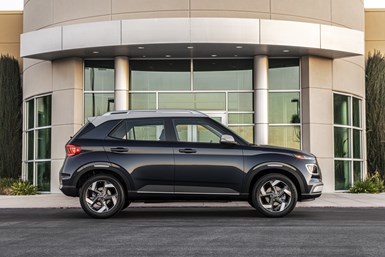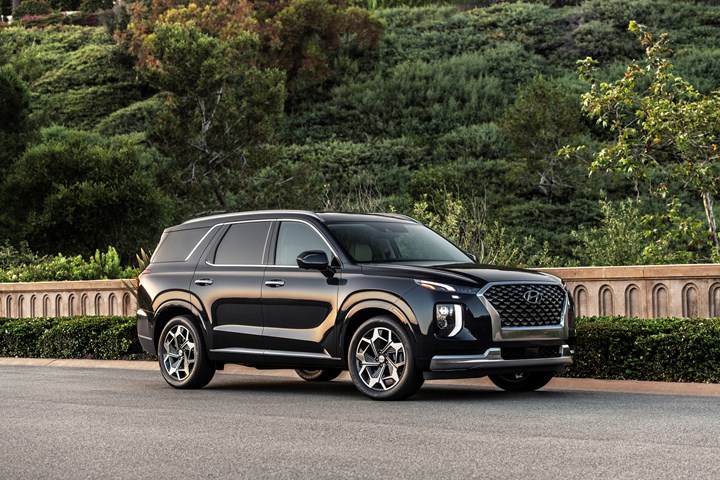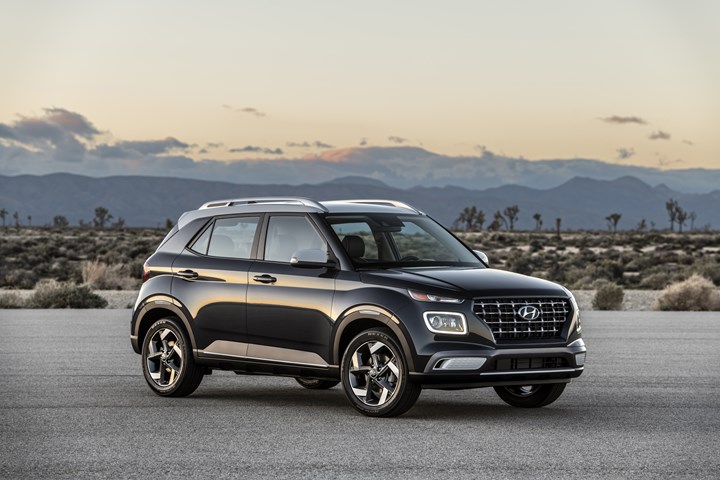2020 Hyundai Venue Denim
Presumably, they’re hoping it will be what the kids are wearing—I mean, driving
There really was a guy named “Levi Strauss.” He was born in Bavaria in 1829, moved to the U.S. in 1847, left New York for San Francisco in 1853, where he stared a wholesale dry goods business. In 1872 Strauss was contacted by a tailor based in Reno, Nevada, who had the idea of riveting the pocket corners on waist overalls, a.k.a., jeans. A patent was granted on the pocket riveting, and first used on what was known as the “XX” pants. While those original 501s had one back pocket, it had the same stitching design that is still used on Levi’s, which is known as “Arcuate.” Two back pockets didn’t arrive until 1901 and the red tab on the back right pocket wasn’t used until 1936.
All of this may be more than you want to know about Levi’s.

The 2020 Hyundai Venue Denim. A small ute. (Images: Hyundai)
But there’s the top-of-its-line Hyundai Venue Denim, Hyundai’s trendy take for its smallest crossover.
This is not like the Levi’s AMC Gremlin of the mid-70s, which was to AMC what Bill Blass was to the ’79 Lincoln Continental: authorized but odd.
No, the Venue Demin isn’t a full-on Levi’s execution, but the product people at Hyundai evidently wanted to provide some differentiation for the little ute, and so as it is aimed at the younger market, clearly they figured that “denim” would have resonance in the way that “flannel” might for a Subaru.
To visually execute this, the exterior has a white top and a blue body. That color scheme is carried into the interior, where the seats have a denim-like cloth inset where your back pockets are located and there is a blue-leatherette surround with white piping. Also, the trim—for the IP and the doors—carry the colors, as well.

Note the seating surfaces.
All in, it is a fresh look that in some ways strikes me as being somewhat more nautical than San Francisco in the late 1960s (when, arguably, Levi’s became a part of the non-agricultural cultural landscape).
Still, going back to the rivets and the red tab of Levi’s, one of the things that Hyundai does exceedingly well is to execute details, both on the exterior (lower-grille insets could have been flat panels, but there are design elements) and interior (the molded arm rest has an additional shape to break up the plain surface).
While I am impressed with the styling of Hyundai models of late, I must admit that I am not all that taken with the Venue. It seems too simple and upright, almost like the sort of thing that you’d find in the toy aisle for a generic “car.” I suspect that this body-side/roofline execution is the solution to the problem of: How do you provide an abundance of interior room for a vehicle that is comparatively compact?
The Venue has a 99.2-inch wheelbase and is 159 inches long. It is 61.6 inches high (without roof rails, with the rails adding 1.1 inches on the Denim), and 69.7 inches wide. Passenger volume is 91.9 cubic inches. So for being small, it is roomy.

The proportions of the Hyundai Palisade seem right. . .

. . .while these proportions are somewhat awkward.
Still, there are the—to my eye—somewhat awkward proportions. To go to the opposite extreme, let’s look at the Hyundai Palisade, which is the Venue’s biggest brother, and has the right proportions.
That is, the Palisade is 196.1 inches long and 68.9 inches high. As mentioned, the Venue is 159 inches long and 61.6 inches high.
The Palisade is 37.1 inches longer (three feet and change) but just 7.3 inches taller than the Venue.
Not even a well-fitting pair of jeans can change that.


.jpg;width=70;height=70;mode=crop)